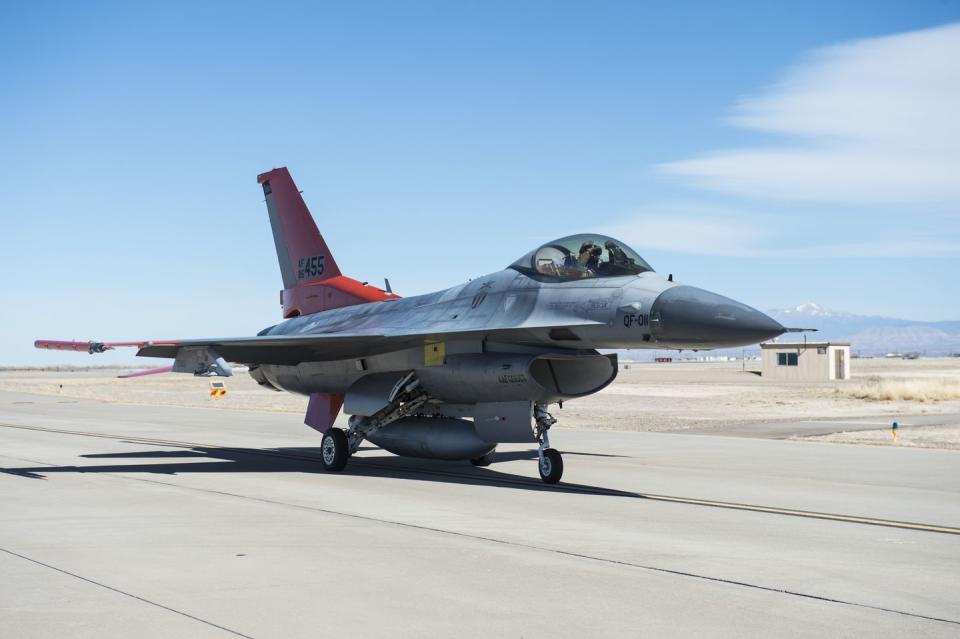It Sure Looks Like China Is Turning Old Fighter Jets Into Drones
China's air force is converting obsolete fighter jets into drones.
The drones could be used as decoys or to carry out their own combat missions.
Unlike manned aircraft, it doesn't matter if a drone gets shot down in combat.
It sure looks like China is converting Cold War fighters into flying drones. Dozens of Shenyang J-16 fighter planes, spotted in satellite photos, are still present at China's military airfields, despite the People's Liberation Army Air Force (PLAAF) retiring the type in 2010. China could use the planes in a conflict, either masquerading them as modern jets, or using the drones to carry out combat missions of their own.
✈︎ Don't miss any of our best-in-class military news. Join our squadron.
Planet Labs—a San Francisco, California-based satellite data company—provided images of the planes to Defense News in October. At least 50 J-6s are visible on the tarmac at Liancheng Airbase.
The J-6 is a copy of the Soviet Union's MiG-19, a single-seat, twin-engine fighter that made its debut in the mid-1950s. The fighter was provided to the People's Republic of China, where at least 2,000 were manufactured under license by the Shenyang Aircraft Corporation. The J-6 was China's first supersonic fighter jet, but had several limitations, with early versions lacking an air-to-air radar.
Speaking of J-6s, the PLA’s Eastern Theater Command recently released photos showing the PLAAF’s J-6 unmanned aircraft conversion. Blurred serials suggest active service; at least 50 can be seen in @planet imagery from September at 1 of 2 bases known to be operating the type pic.twitter.com/HvvMrpnjtB
— Mike Yeo 杨启铭 (@TheBaseLeg) October 20, 2021
By the 1980s, the J-6 was already obsolete; the fact that it served until 2010 is indicative of how poorly equipped the PLAAF was until just recently.
According to Defense News, reports surfaced in China in 2013 that the PLAAF was turning the planes into drones, "for use either as a decoy to overwhelm adversary air defences by their sheer numbers, or as a rudimentary unmanned combat aircraft."
A J-6 drone is a cheap solution for both missions. Enemy radar systems will register a J-6 as a potential threat, and, barring the detecting of any onboard radar or stray electromagnetic signals, warn adversaries that a small, fast, fighter-like aircraft is quickly approaching. This could cause a foreign air force, like Taiwan's, to scramble together fighters to meet them, pulling the planes away from other, more important missions.
J-6s also have six wing-mounted hardpoints, allowing them to carry infrared-guided air-to-air missiles or air-to-ground munitions. It's even conceivable that robotic J-6s could be used for one-way missions, loaded with bombs and then sent on suicide runs against heavily defended targets.

As it happens, the U.S. Air Force also turns obsolete aircraft into drones. Early model F-16A fighters, retired from frontline service, have been turned into QF-16 (Q for drone, F for fighter) optionally manned target drones. The drones retain the ability to be flown by a human pilot sitting in the cockpit, but can also be quickly converted into a remote-controlled aircraft. Uncrewed, they are controlled by two pilots at a ground control station. The tails of each jet are painted bright orange for identification purposes.
The first QF-16 drone was converted in 2013. The QF-16 is still surprisingly agile, executing sharp maneuvers at up to 7Gs. It is also capable of flying to altitudes of 40,000 feet and has a top speed of 1,118 miles per hour.
Unlike China, Air Force drone conversions are used purely as aerial targets. QF-16s are used to mimic manned aircraft, twisting and turning and maneuvering to present a challenge to a missile's guidance system. There's been some talk outside of the military of turning QF-16s into combat drones, but nothing official. The Air Force, so far, has preferred buying new drones such as the MQ-9 Reaper or the upcoming Loyal Wingman concept for combat missions.
🎥 Now Watch This:
You Might Also Like

